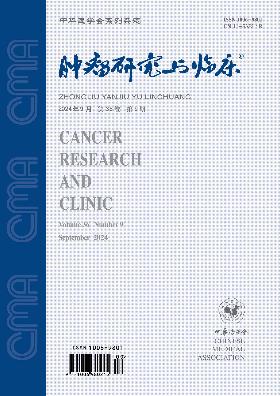Value of enhanced recovery after surgery in D2 radical resection of distal gastric cancer under total laparoscopy and its effect on inflammatory factors
Q4 Medicine
引用次数: 0
Abstract
Objective To investigate the value of enhanced recovery after surgery (ERAS) in D2 radical resection of distal gastric cancer under total laparoscopy and its effect on inflammatory factors. Methods The clinical data of 50 patients with distal gastric cancer at Hanzhong Central Hospital from March 2016 to October 2017 were retrospectively analyzed. The patients were divided into the observation group (25 cases) and the control group (25 cases). The observation group received totally laparoscopic radical D2 gastrectomy for distal gastric cancer under the guideline of ERAS; the control group received totally laparoscopic radical D2 gastrectomy for distal gastric cancer under the guideline of the traditional method. The changes of perioperative related indexes, postoperative recovery and postoperative inflammatory indexes were compared between the two groups. Results All 50 patients successfully completed the operation. The operation time was (287.2±52.3) min and (296.8±57.9) min, respectively of the observation group and the control group; the number of lymph node dissection was (34.0±11.0) and (34.6±14.3), respectively of the observation group and the control group. There were no significant differences in the above indexes between the two groups (all P > 0.05). The hospitalization time, the hospitalization cost, the postoperative time of getting out of bed of the observation group was (22.0±2.8) d, (61 044.4±4 692.7) yuan, (12.8±1.8) h. The hospitalization time, the hospitalization cost, the postoperative time of getting out of bed of the control group was (23.9±1.9) d, (63 875.81±4 392.6) yuan, (23.7±8.2) h. And there were statistically significant differences between the two groups (all P 0.05). There were no statistically significant differences in the tumor necrosis factor α, interleukin-6 (IL-6), C-reactive protein and procalcitonin on the day before the operation of both groups (all P > 0.05); the levels of above four factors in the observation group were lower than those in the control group on the 1st, 4th and 7th day after the operation, and the differences were statistically significant (all P < 0.05). Conclusion The application of ERAS in totally laparoscopic radical resection of gastric cancer can improve the postoperative condition, significantly reduce the inflammatory reaction of patients, which has a certain value of improving the quality of life of patients. Key words: Gastric neoplasms; Laparoscopy, D2 radical resection; Inflammation; Cytokines; Enhanced recovery after surgery全腹腔镜下癌症远端D2根治术术后恢复增强的价值及其对炎症因子的影响
目的探讨全腹腔镜下增强术后恢复(ERAS)在癌症远端D2根治术中的应用价值及其对炎症因子的影响。方法回顾性分析2016年3月至2017年10月汉中市中心医院收治的50例癌症远端患者的临床资料。将患者分为观察组25例和对照组25例。观察组在ERAS指导下,对癌症远端行全腹腔镜D2根治术;对照组在传统方法指导下,对癌症远端行全腹腔镜D2根治术。比较两组围手术期相关指标、术后恢复情况及术后炎症指标的变化。结果50例患者均顺利完成手术。观察组和对照组手术时间分别为(287.2±52.3)min和(296.8±57.9)min;观察组和对照组淋巴结清扫次数分别为(34.0±11.0)和(34.6±14.3)。观察组住院时间、住院费用、术后下床时间分别为(22.0±2.8)d、(61044.4±4692.7)元、(12.8±1.8)h,对照组术后下床时间分别为(23.9±1.9)d、(63 875.81±4 392.6)元、(23.7±8.2)h,C反应蛋白和降钙素原在两组手术前一天的变化(均P>0.05);术后第1、4、7天观察组上述4个因素水平均低于对照组,差异有统计学意义(均P<0.05),显著降低患者的炎症反应,对提高患者的生活质量有一定的价值。关键词:胃肿瘤;腹腔镜,D2根治性切除术;炎症;细胞因子;术后恢复增强
本文章由计算机程序翻译,如有差异,请以英文原文为准。
求助全文
约1分钟内获得全文
求助全文
来源期刊

肿瘤研究与临床
Medicine-Oncology
CiteScore
0.10
自引率
0.00%
发文量
7737
期刊介绍:
"Cancer Research and Clinic" is a series of magazines of the Chinese Medical Association under the supervision of the National Health Commission and sponsored by the Chinese Medical Association.
It mainly reflects scientific research results and academic trends in the field of malignant tumors. The main columns include monographs, guidelines and consensus, standards and norms, treatises, short treatises, survey reports, reviews, clinical pathology (case) discussions, case reports, etc. The readers are middle- and senior-level medical staff engaged in basic research and clinical work on malignant tumors.
 求助内容:
求助内容: 应助结果提醒方式:
应助结果提醒方式:


